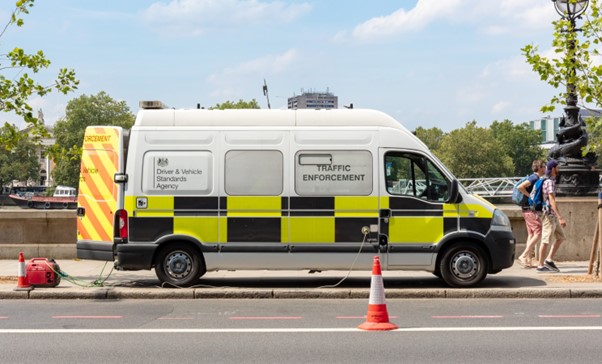
Susie Jones
Controalele DVSA pentru vehiculele grele de marfă explicate
Creat: 08.08.2024
•
Actualizat: 08.08.2024
Pe parcursul carierei dumneavoastră de șofer de camion, este posibil să fiți oprit de către Agenția pentru Standarde pentru Șoferi și Vehicule (DVSA). Pentru șoferii de camioane nou-veniți în industrie, acesta poate fi un proces descurajant. Cu toate acestea, înțelegerea aspectelor esențiale ale controalelor DVSA pentru camioane poate face procesul mai puțin stresant.
Cine este DVSA?
Conform Gov.uk, DVSA este responsabilă pentru "efectuarea de controale rutiere asupra șoferilor și vehiculelor comerciale pentru a se asigura că aceștia respectă normele de siguranță și că vehiculul lor poate fi condus în siguranță".
DVSA poate efectua verificări la fața locului ale camionului dumneavoastră și poate emite interdicții. Interdicțiile împiedică un șofer de camion să conducă până când problema cu vehiculul său este rezolvată.
Poliția are, de asemenea, autoritatea de a opri un șofer de camion și de a efectua verificări similare.
Cum arată examinatorii DVSA?
Există câteva modalități de a identifica un examinator DVSA. Aceștia vor purta veste de vizibilitate galbene cu sigla DVSA și vor avea întotdeauna un card de mandat. Vehiculele lor au un imprimeu negru și galben cu sigla DVSA pe capotă.

Ce se întâmplă dacă sunteți tras pe dreapta?
A nu opri atunci când un examinator DVSA îți cere acest lucru constituie o infracțiune. Dacă un examinator vă solicită să trageți pe dreapta, acesta va efectua verificarea pe marginea drumului sau la un loc special de testare. Scopul principal al acestor opriri este de a menține vehiculele nesigure în afara șoselelor.
Un examinator va efectua următoarele verificări obligatorii:
Verificarea greutății autorizate a încărcăturii și a tipului de încărcătură
Verificarea defecțiunilor mecanice și a inspecției tehnice
Asigurați-vă că înregistrările tahografului sunt corecte
Asigurați-vă că aveți un permis de conducere valabil.
Cât durează un control DVSA walkaround?
În medie, un control DVSA va dura 15 minute. Cu toate acestea, pentru cazurile în care autocamionul nu îndeplinește cerințele de siguranță, poate dura mai mult. Examinatorul trebuie să efectueze verificările necesare, indiferent de timp.
Cum să vă asigurați că vehiculul dvs. este apt de circulație
Este responsabilitatea șoferului să se asigure că autocamionul său este apt de circulație. Se recomandă efectuarea unei verificări de parcurs înainte de fiecare călătorie.
Verificați următoarele elemente:
Luminile
Indicatori
Combustibil și ulei
Anvelope
Fixarea roților
Bodywork
Cuplarea remorcii
Încărcătură și alte echipamente
Verificări ale vehiculului în cabină (de exemplu, centuri de siguranță, claxon, ștergătoare, spălătoare, direcție și indicator de înălțime).
În plus, este responsabilitatea șoferului de camion să raporteze în scris orice defecțiune organizației sale. Acestea ar trebui să includă următoarele:
Marca de înmatriculare sau de identificare a vehiculului
Data inspecției
Detalii privind defectele
Numele persoanei care raportează defectele.
Responsabilitățile operatorului
Operatorii vehiculelor sunt responsabili pentru asigurarea siguranței vehiculelor lor și trebuie să îndeplinească următoarele cerințe:
Operatorul trebuie să se asigure că toate vehiculele comerciale sunt supuse unor inspecții de siguranță periodice
Ei trebuie să se asigure că șoferii lor înțeleg ce verificări trebuie să aibă loc.
Interdicții rutiere
Dacă autocamionul dvs. nu este apt de circulație, DVSA vă poate emite două notificări de interdicție diferite - imediată sau amânată.
Aviz de interdicție imediată:
Aceasta poate intra în vigoare imediat
În majoritatea cazurilor, aceasta va duce la imobilizarea vehiculului
Interdicțiile imediate pot duce la o urmărire penală.
Notificare de interdicție întârziată:
Operatorul are la dispoziție până la 10 zile pentru a rezolva problemele
După zece zile, polițiștii vor inspecta din nou vehiculul
Interdicțiile trebuie eliminate înainte ca autocamionul să poată fi condus.
Interdicții privind inspecția tehnică
În cazul în care autocamionul are probleme mecanice sau caroseria și echipamentul sunt de calitate slabă, atunci se acordă o interdicție de circulație. Pentru vehiculele din afara Regatului Unit, șoferul va primi o interdicție imediată. Pentru operatorii din Regatul Unit, tipul de interdicție va depinde de gravitatea defecțiunii.
Defecte minore:
Defectele minore pot duce la o interdicție întârziată
Operatorul va avea la dispoziție până la zece zile pentru a remedia orice defecțiune
O nouă inspecție va avea loc după zece zile.
Defecte grave:
Conducătorul auto va primi o interdicție marcată cu "S" pentru un defect grav
O interdicție marcată cu "S" apare atunci când există o problemă de întreținere
Dacă examinatorul decide că nu există un risc imediat, atunci interdicțiile pot fi amânate
Vehiculul va fi imobilizat și veți putea fi urmărit penal.
O interdicție marcată cu "S" nu va apărea pentru următoarele:
Dacă a apărut o problemă în timpul călătoriei
Problema nu a putut fi detectată (de exemplu, un defect la partea inferioară).

Interdicții de supraîncărcare
Dacă vehiculul este supraîncărcat, un examinator DVSA îl poate imobiliza. Alternativ, examinatorul poate direcționa camionul către o locație din apropiere, unde încărcătura poate fi redistribuită sau îndepărtată. Operatorul vehiculului va primi o notificare.
Interdicții privind orele șoferului
Conducătorii auto care nu au respectat normele privind tahograful și orele de condus vor primi o interdicție. Acest lucru poate duce la o amendă, o urmărire penală sau vehiculul poate fi imobilizat.
Citiți mai multe despre normele și reglementările privind tahograful
Deși examenele DVSA pot fi o perspectivă descurajantă pentru șoferii de camioane, acestea reprezintă în mod incontestabil o forță pozitivă pentru siguranța rutieră. Dacă vă asigurați că efectuați verificările corecte și respectați normele și reglementările esențiale, examinarea DVSA va decurge fără probleme.
Cât timp trebuie să păstrați fișele de defecțiuni ale camioanelor?
Implementarea unui sistem de raportare a defectelor zero poate fi prima dvs. linie de apărare atunci când demonstrați că vehiculele dvs. sunt în stare de funcționare. Lucrările de remediere a defectelor trebuie raportate și păstrate timp de până la 15 luni. În cazul în care nu există defecte, compania trebuie să păstreze înregistrări pentru a se asigura că șoferii își efectuează verificările.
Cât de des aveți nevoie de un control medical pentru a vă păstra permisul?
Pentru a obține și a deține un permis HGV, este obligatoriu să efectuați un examen medical HGV - fără acesta, nu vi se va elibera un permis.
Pentru șoferii sub 45 de ani, examenul medical va dura până la împlinirea vârstei de 45 de ani. Cu toate acestea, după această vârstă, vi se va cere să treceți testul medical la fiecare cinci ani, până la vârsta de 65 de ani. Șoferii de 65 de ani și peste sunt obligați să treacă evaluarea medicală în fiecare an.



